| Pages:
1
2
3 |
Sauron
International Hazard
    
Posts: 5351
Registered: 22-12-2006
Location: Barad-Dur, Mordor
Member Is Offline
Mood: metastable
|
|
Easy Route to Acetonedicarboxylic acid?
The usual method for preparing this interesting compound, employed in a number of fascinating Mannich condensations, is to oxidize anhydrous citric
acid in the cold with fuming sulfuric acid, hardly a very convenient process. For one thing the acetonedicarnoxylic acid product has to be
scrupulously washed free from all traces of sulfuric acid, or it will soon decompose.
For another, fuming sulfuric acid isn't cheap.
TCCA is cheap, and selectively oxidizes secondary hydroxyls, so maybe it will work with citric acid's hydroxyl group and thus bring about the
decarboxylation to acetonedicarboxylic acid, providing a cleaner, stabler product.,
Worth a try, don't you think?
Some of the Mannich reactions employing this b-ketogluaric acid, its esters or anhydride are doubtless familiar to some of the B's from the Hive as
they lead to well known and popular derivatives of tropinone.
|
|
|
Maya
Hazard to Others
  
Posts: 263
Registered: 3-10-2006
Location: Mercury
Member Is Offline
Mood: molten
|
|
I'ved used fuming and that worked fine after washing with ether.
Also used chlorosulfonic followed by MeOH then extarction with CHCl3 and distillation to get the Di-ester.
But never heard or tried of using TCCA, why would you think it would work?
\"Prefiero ser yo extranjero en otras patrias, a serlo en la mia\"
|
|
|
Sauron
International Hazard
    
Posts: 5351
Registered: 22-12-2006
Location: Barad-Dur, Mordor
Member Is Offline
Mood: metastable
|
|
Because the hydroxyl group in citric acid (the alcoholic hydroxyl not the carboxylic ones) is secondary. TCCA is selective for secondary or benzylic
hydroxyls, so I see no reason why it should not work on a secondary hydroxyl that is beta to a carboxyl group.
Easy enough to just give it a try. I have plenty citric acid, and will order a few Kg TCCA. I want to try it on glycerine as well. Ought to be a
facile way to get 1,3 hydroxyacetone, as the TCCA doesn't oxidize the primary hydroxyls at all (or more precisely the rates are very different, so
it's effectively highly selective.)
It's cheap enough from Acros, $50/kg. If I can find a pool supply house it'll be a lot cheaper than that but Bangkok has few swimming pools.
|
|
|
Nicodem
Super Moderator
      
Posts: 4230
Registered: 28-12-2004
Member Is Offline
Mood: No Mood
|
|
Acetone dicarboxylic acid and its esters have two quite acidic methylene groups (pKa of about 10), acidic more than enough to get chlorinated by TCCA
extremely easily, even in neutral media, while for sure in acidic reaction media (HCl is a by product of the oxidation step). So there is no way to
stop the oxidation of citric acid at the acetone dicarboxylate stage if using trichloroisocyanuric acid. Besides, citric acid is formally a tertiary
alcohol and the mechanism of oxidation by fuming H2SO4 is of a particular kind which might not necessarily apply to TCCA as oxidant.
…there is a human touch of the cultist “believer” in every theorist that he must struggle against as being
unworthy of the scientist. Some of the greatest men of science have publicly repudiated a theory which earlier they hotly defended. In this lies their
scientific temper, not in the scientific defense of the theory. - Weston La Barre (Ghost Dance, 1972)
Read the The ScienceMadness Guidelines!
|
|
|
Sauron
International Hazard
    
Posts: 5351
Registered: 22-12-2006
Location: Barad-Dur, Mordor
Member Is Offline
Mood: metastable
|
|
Oh well, que sera sera. Thanks.
|
|
|
shadow
Hazard to Self
 
Posts: 52
Registered: 17-10-2007
Member Is Offline
Mood: No Mood
|
|
This thread may be very old, but there is a Chinese patent out there using hydrogen peroxide to oxidize the citric acid for 1,3 acetonedicarboxylic
acid.
[Edited on 16-9-2015 by shadow]
|
|
|
Boffis
International Hazard
    
Posts: 1836
Registered: 1-5-2011
Member Is Offline
Mood: No Mood
|
|
@shadow, do you ahve some more details of the patent like a number etc.?
|
|
|
Crowfjord
Hazard to Others
  
Posts: 390
Registered: 20-1-2013
Location: Pacific Northwest
Member Is Offline
Mood: Ever so slowly crystallizing...
|
|
Found it. The patent is CN 103288628. The following is copied from the google translation:
[0021] Example 1
Equipped with a reflux condenser, a stirrer, a thermometer, 500ml round bottom flask was added citric acid monohydrate 210g (lmol), 50ml of water was
added, raising the temperature to 55 ° C, then began a 30% solution of hydrogen peroxide an aqueous solution of 136g (1.2mol), was observed to bubble
out uniformly, with the addition of an aqueous solution of hydrogen peroxide, the reaction temperature is gradually increased, after the completion of
the dropwise addition, at 95 ° C for 3 hours, water was evaporated to dryness under reduced pressure Weighing, the products of 1,3-acetone
dicarboxylic acid 141g (0.97mol), yield %% 97% purity, mp I35O (decomposition).
I don't know much about this reaction, does it seem weird that no catalyst (acid, base, metal) is employed?
|
|
|
Waffles SS
Fighter
   
Posts: 998
Registered: 7-12-2009
Member Is Offline
|
|
Interesting If it work !
I searched this compound in reaxys for all possible way for synthesis
Attachment: Acetonedicarboxylic acid.pdf (246kB)
This file has been downloaded 1499 times
[Edited on 18-9-2015 by Waffles SS]
|
|
|
shadow
Hazard to Self
 
Posts: 52
Registered: 17-10-2007
Member Is Offline
Mood: No Mood
|
|
Here is the site:
Crow has it right.
Various examples are given
http://www.google.com/patents/CN103288628A?cl=en
shad
|
|
|
nlegaux
Hazard to Self
 
Posts: 93
Registered: 28-11-2014
Location: East Tennessee
Member Is Offline
Mood: No Mood
|
|
Would it be possible to create acetonedicarboxylic acid by reacting formaldehyde and a haloacetic acid?
nlegaux
|
|
|
byko3y
National Hazard
   
Posts: 721
Registered: 16-3-2015
Member Is Offline
Mood: dooM
|
|
nlegaux, no.
|
|
|
gdflp
Super Moderator
      
Posts: 1320
Registered: 14-2-2014
Location: NY, USA
Member Is Offline
Mood: Staring at code
|
|
Quote: Originally posted by nlegaux  | Would it be possible to create acetonedicarboxylic acid by reacting formaldehyde and a haloacetic acid?
nlegaux |
How are you suggesting the two carbon-carbon bonds are formed?
|
|
|
Boffis
International Hazard
    
Posts: 1836
Registered: 1-5-2011
Member Is Offline
Mood: No Mood
|
|
nlegaux's idea above set me thinking, instead of formaldehyde how about nitromethane?
Treat nitromethane with a base to generate a nitrolic acid salt and then react with sodium chloroacetate to get the Na salt of 3-nitropropanoic acid.
Then again base catalysed condensation of this compound with sodium glyoxylate to get either 3-nitro-2-pentenedioic acid or
2-hydroxy-3-nitropentanedioic acid depending on whether or not dehydration occurs. Sound plausible anybody?
If it works this far the next step should be easy, after all the conversion of alpha-hydroxy-nitroalkanes or conjugate nitro alkenes to ketones are
probably the two most extensively discussed topics on this forum! 
Not quite as simple as the hydrogen peroxide route I admit but somewhere on this forum a paper was once posted about the oxidation of citric acid with
hydrogen peroxide and I seem to recall that the products were complex so just because its in a patent doesn't necessarily mean its going to work. I
think this is the paper as best I recall:
Attachment: Oxidation of quinic acid- to citric acetone dicarboxylic and malonic acids JExBot Hulmes & Arthington 1953.pdf (743kB)
This file has been downloaded 531 times
|
|
|
PHILOU Zrealone
International Hazard
    
Posts: 2893
Registered: 20-5-2002
Location: Brussel
Member Is Offline
Mood: Bis-diazo-dinitro-hydroquinonic
|
|
Just thinking out loud:
CH3-CO-CH3 + Cl2 --> Cl-CH2-CO-CH2-Cl (lacrymogen and probably carcinogen/ strong alkylating agent)
Cl-CH2-CO-CH2-Cl + 2 Na-C#N --> N#C-CH2-CO-CH2-C#N + 2 NaCl
N#C-CH2-CO-CH2-C#N + 2 H2O -heat/mild acid-> NH4O2C-CH2-CO-CH2-CO2NH4
PH Z (PHILOU Zrealone)
"Physic is all what never works; Chemistry is all what stinks and explodes!"-"Life that deadly disease, sexually transmitted."(W.Allen)
|
|
|
Waffles SS
Fighter
   
Posts: 998
Registered: 7-12-2009
Member Is Offline
|
|
I tried to make Acetonedicarboxylic acid according to CN103288628 but i got unchanged Citric acid.
After adding H2O2 at 60c to Citric acid solution no bubble released and temp did not increase.
I got clear crystal after refluxing solution for 3-4 Hour at 94c and evaporating the solution at reduced pressure. according to FTIR spectra that is
Citric acid.
Someone has tried this method ?
[Edited on 27-9-2015 by Waffles SS]
|
|
|
PHILOU Zrealone
International Hazard
    
Posts: 2893
Registered: 20-5-2002
Location: Brussel
Member Is Offline
Mood: Bis-diazo-dinitro-hydroquinonic
|
|
Another possible way:
HO2C-CH2-C(-CO2H)(-OH)-CH2-CO2H + halogenating agent --> HO2C-CH2-C(-CO2H)(-X)-CH2-CO2H
HO2C-CH2-C(-CO2H)(-X)-CH2-CO2H + AgNO2 --> HO2C-CH2-C(-CO2H)(-NO2)-CH2-CO2H + AgCl (s)
(part of the nitro enters as nitrite ester!)
HO2C-CH2-C(-CO2H)(-NO2)-CH2-CO2H -spontaneous decarboxylation-> HO2C-CH2-CH(-NO2)-CH2-CO2H + CO2
Then usual conversion of secondary nitrocompound to ketonic group.
[Edited on 27-9-2015 by PHILOU Zrealone]
PH Z (PHILOU Zrealone)
"Physic is all what never works; Chemistry is all what stinks and explodes!"-"Life that deadly disease, sexually transmitted."(W.Allen)
|
|
|
Waffles SS
Fighter
   
Posts: 998
Registered: 7-12-2009
Member Is Offline
|
|
Thanks PHILOU Zrealone,that is good idea but little expensive
In reaxys search(i put PDF file of it above) there is interesting reaction.
| Quote: |
H2O + Citric acid + Mn2(SO4)3 + K2SO4 = Acetonedicarboxylic acid + Acetone
Reaktion des Trinatriumcitrats beim BelichtenMacMahon; Srivastava; Journal of the Indian Chemical Society; vol. 23;
(1946); p. 262; Current Science; vol. 15;(1946); p. 249; ; (1947); p. 1921
|
it seems reference is not available 
also another reaction of this reference used FeCl3 instead of K2SO4.
I think oxidation of Citric acid to Acetonedicarboxylic acid is possible even with alone KMnO4 but there is no guarantee that over
oxidation do not happen
|
|
|
Sydenhams chorea
Harmless

Posts: 29
Registered: 16-8-2009
Member Is Offline
Mood: No Mood
|
|
Quote: Originally posted by Waffles SS  | | Quote: |
H2O + Citric acid + Mn2(SO4)3 + K2SO4 = Acetonedicarboxylic acid + Acetone
Reaktion des Trinatriumcitrats beim BelichtenMacMahon; Srivastava; Journal of the Indian Chemical Society; vol. 23;
(1946); p. 262; Current Science; vol. 15;(1946); p. 249; ; (1947); p. 1921
|
it seems reference is not available 
|
Current Science is available for free online, but that last one (1947) p 1921 is wrong, the volume only +- 300 pages, and nowhere is a Srivastava to
be found, neither in other volumes.
I attached volume 15 (1946) p 249. In ithe author says that he examined photochemical reactions of I2 in aq. KI on sodium citrate in light
(1000W incandescent) and he added that addition of Mn(II) and Cr(III) salts are most effective. There's not much else he says.
| Quote: |
also another reaction of this reference used FeCl3 instead of K2SO4.
I think oxidation of Citric acid to Acetonedicarboxylic acid is possible even with alone KMnO4 but there is no guarantee that over
oxidation do not happen
|
KMnO4 oxidation is described in Comptes Rendus 130 (1900) p 32-34. It used to be available to download from the Bibliothèque Nationale de France
(Gallica) but they changed their format to tablet style and it seems a lot of functions are not working. So I'll post the link: http://gallica.bnf.fr/ark:/12148/bpt6k3086n/f34.item.r=Denig...
Overoxidation to acetone and CO2 is unavoidable unless the acetonedicarboxylic acid is precipitated immediately as it forms. The author
used mercuric sulfate for that, from which acetonedicarboxylic acid can be recovered with a stream of H2S:
(from French) 10g citric acid was dissolved in 20ml hot water and 3g KMnO4 was dissolved in 100ml hot water. Both solutions were brought to
15°C and the permanganate solution was added to the citric acid solution in a water-bath taking care that the temperature didn't rise above 30-35°C.
After a couple of hours of standing, the liquid, which had now attained a yellow colour, was added to 100ml of a hot HgSO4 solution
previously brought to a boil. A great amount of white precipitate was recovered by filtration, washed with water, and suspended in water where it is
decomposed with a stream of H2S. After filtrating the mixture was extracted with ether, from which acetonedicarboxylic acid was recovered.
Attachment: article_id_015_09_0249_0250_0.pdf (148kB)
This file has been downloaded 526 times
EDIT:
I also added "Effect of metal ions on acetone dicarboxylic acid catalyzed peroxomonosulphate reactions", Journal of Molecular Catalysis A Volume 390,
August 2014, Pages 22–28., where the oxidation of oxidation of Fe(III), Ni(II) and Co(II) citrates by peroxomonosulphate (PMS, Oxone) in the pH
range 3.0–6.0 is examined.
"Conclusion The oxidation of citric acid by peroxomonosulphate in the pH range 3.0–6.0 (citric acid buffer) occurs only in the presence of a metal
ion. The Fe(III), Co(II) and Ni(II) citrates follow auto catalyzed mechanism. Acetone dicarboxylic acid is the product which catalyzes the oxidation
of metal citrate. In the absence of meta lions, acetone dicarboxylic acid catalyzes the decomposition of PMS at pH 3.0–6.0 as in ketone catalyzed
one at neutral or weak alkaline pH. However, the complexation with metal ion changes the mechanism to the acetone dicarboxylic acid catalyzed
oxidation of metal–citrate by PMS."
[Edited on 2-10-2015 by Sydenhams chorea]
Attachment: ragukumar2014.pdf (690kB)
This file has been downloaded 617 times
[Edited on 2-10-2015 by Sydenhams chorea]
Il n'y a point de sots si incommodes que ceux qui ont de l'esprit.
François de La Rochefoucauld.
|
|
|
Waffles SS
Fighter
   
Posts: 998
Registered: 7-12-2009
Member Is Offline
|
|
Thanks @Sydenhams chorea,
That is great.
Maybe we can use Barium or Calcium salts instead of Mercury sulfate for precipitating Acetonedicarboxylic salt.This need to know which salt of
Acetonedicarboxylic is insoluble in water.
[Edited on 2-10-2015 by Waffles SS]
|
|
|
Sydenhams chorea
Harmless

Posts: 29
Registered: 16-8-2009
Member Is Offline
Mood: No Mood
|
|
Quote: Originally posted by Waffles SS  | Thanks @Sydenhams chorea,
That is great.
Maybe we can use Barium or Calcium salts instead of Mercury sulfate for precipitating Acetonedicarboxylic salt.This need to know which salt of
Acetonedicarboxylic is insoluble in water.
[Edited on 2-10-2015 by Waffles SS] |
I am more concerned about generating H2S. Although soluble mercury salts have to be handled with care, I feel more comfortable carefully
handling solid then setting up a H2S-generator. For 10g of citric acid the equimolar amount of acetonedicarboxylic acid is 7.61g (assuming
full conversion) so that would require about 16g of HgSO4, which is not such a great amount. Besides, after precipitating with
H2S, all mercury is recovered as the sulfide (cinnaber).
HgSO4 decomposes in water into HgSO4.2HgO (mercuric subsulfate) and H2SO4. The subsulfate is a yellow
insoluble compound, but does dissolve in a hot diluted sulfuric acid.After isolating and washing the Hg(II) complex I would suggest to suspend it in
dilute HCl and carefully add the equivalent amount of ammonium sulfide required to generate the necessary amount of H2S in situ.
As for trying other metals, better to chose those with a high atomic mass who also can be recovered as insoluble sulfides such as lead, bismuth, tin,
zinc, antimony.
Attached is another method of oxidation of citric acid with Mn(III), an aqueous suspenion of freshly precipitated Mn2O3, which
they prepared by mixing warm aqueous solutions of 50g MnSO4 and 20g KMnO4, filtering the precipitate and washing with water. It
is probably the gamma-polymorph analoguous to the gamma-polymorph of MnO2 prepared in this manner with twice the amount of permanganate,
and known as the most active, desired form for use in organic synthesis. Two polymorphs of Mn2O3 are known, alpha- and gamma-.
The paper doesn't specify any mount, they just state that citric acid is added to the stirring suspension of oxidant.
Attachment: Mn2O3_Chem.Zentr.1917.pdf (568kB)
This file has been downloaded 558 times
Il n'y a point de sots si incommodes que ceux qui ont de l'esprit.
François de La Rochefoucauld.
|
|
|
shadow
Hazard to Self
 
Posts: 52
Registered: 17-10-2007
Member Is Offline
Mood: No Mood
|
|
@Waffles
I tried CN103288628 last year, my first sample melted at 139, and I got excited, but subsequent samples were higher around the mp of citric acid. I
set the product aside, but I'm looking for something that one or the other, but not both is soluble in.
|
|
|
Waffles SS
Fighter
   
Posts: 998
Registered: 7-12-2009
Member Is Offline
|
|
I had no success by this method too.
No bubble and no heat after adding H2O2.
It seems registration of bullshit patent is not difficult in china!
|
|
|
Boffis
International Hazard
    
Posts: 1836
Registered: 1-5-2011
Member Is Offline
Mood: No Mood
|
|
@shadow and Waffles; I know it is not mentioned in the chinese patent but in every case that I have used H2O2 as an oxidising agent in organic systems
there is always a catalyst such a tungstate (amino to nitro groups), ferric nitrate (substituted N-heterocylics to heterocyclic carboxylic acids),
ferrous acetate (carbohydrates to sacchric acid or similar) etc.
With citric acid forming remarkably stable stable complexes with ferric iron I think that iron based catalyst probably will not work but tungstate or
heteropoly tungstophorphoric acid and similar derivatives may be better. Also give the reference to the use of hydrated Mn3+/Mn4+ oxide a manganese
compound may also work.
I am not at home at present but when I am I may look into these possibilities.
|
|
|
ronstark
Harmless

Posts: 37
Registered: 10-10-2016
Member Is Offline
Mood: No Mood
|
|
10g Citric Acid was dissolved in 20mL boiling dH2O.
Solution #1 was cooled to 15°C.
3g KMnO4 was dissolved in 100mL boiling dH2O.
Solution #2 was cooled to 15°C.
Solution #1 was added dropwise over solution #2.
The temperature was kept between 30°C - 35°C upon addition (10 minutes).
Fizzing and bubbling indicating the evolution of CO2.
The smell is reminiscent of Coca-Cola.
After 2h on standing, the liquid, which had now attained a yellow colour, was esterified with NaOH and EtOH.
Let's see in the morning if something precipitates out.
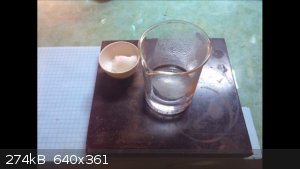 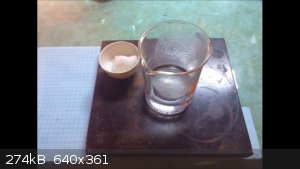 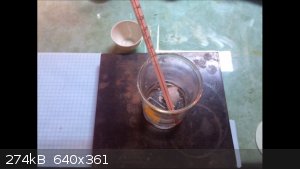 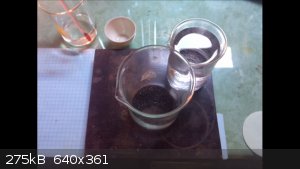 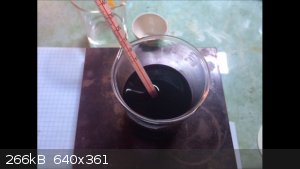 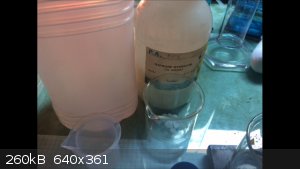 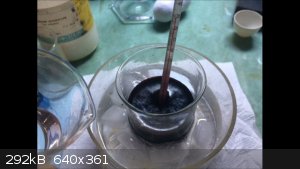 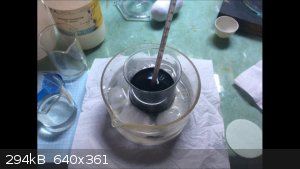 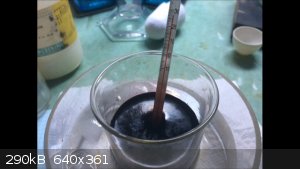 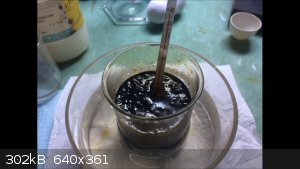 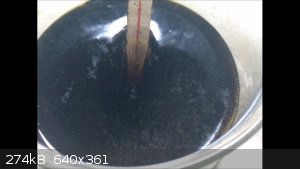 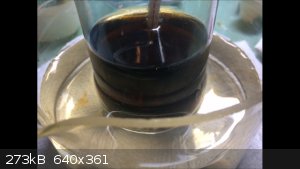 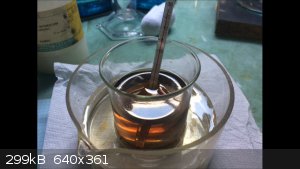 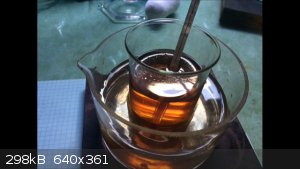
[Edited on 5-6-2017 by ronstark]
|
|
|
| Pages:
1
2
3 |